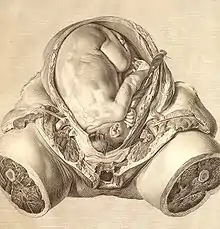Jan van Rymsdyk
Jan van Rymsdyk (also Rijmsdijck, Riemsdyk, Remsdyke) (c. 1730 - c. 1790)[1][2] was a Dutch painter and engraver.
Life
Rymsdyk was active The Hague in the late 1740s but was in London by 1750. In 1758 he moved away to Bristol and practised as a portrait-painter; in 1764 he returned to London.[1][2]
Works

In 1767 Rymsdyk executed a mezzotint engraving of Frederick Henry and Emilia Van Solms, Prince and Princess of Orange, from a painting by Jacob Jordaens at Devonshire House. His skill brought him work with William Hunter, and he executed some of the engravings for Hunter's Anatomia Humani Gravidi Uteri (1774). In 1778, with his son Andrew, he published a series of plates from antiquities and curiosities in the British Museum, Museum Britannicum (second, revised edition 1791).[3]
Family
His son, Andreas van Rymsdyk, gained a medal at the Society of Arts in 1767, and in 1778 exhibited two enamels at the Royal Academy. He assisted his father in his works, and died at Bath in 1786.[3][4]
Notes
- Kornell, Monique. "Rymsdyk, Jan van". Oxford Dictionary of National Biography (online ed.). Oxford University Press. doi:10.1093/ref:odnb/28100. (Subscription or UK public library membership required.)
- Jan van Rijmsdyck at the RKD website
- Lee, Sidney, ed. (1899). . Dictionary of National Biography. 58. London: Smith, Elder & Co.
- Andreas van Rijmsdijck at the RKD website
| Wikimedia Commons has media related to Jan van Rymsdyk. |
Attribution
![]() This article incorporates text from a publication now in the public domain: Lee, Sidney, ed. (1899). "Van Rymsdyk, Jan". Dictionary of National Biography. 58. London: Smith, Elder & Co.
This article incorporates text from a publication now in the public domain: Lee, Sidney, ed. (1899). "Van Rymsdyk, Jan". Dictionary of National Biography. 58. London: Smith, Elder & Co.